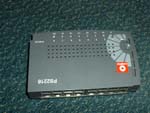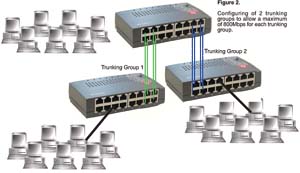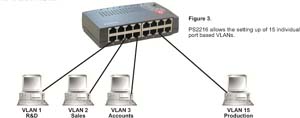Compex PS2216 Switch
Review by Harry Lam
on 02.12.03
Switch provided by Compex,
MSRP: $89.95
Testing:
Well then, enough of me explaining technical terms, on with some pictures and my reflections on this product!
The PS2216 is a pretty compact product, and I was somewhat surprised that it could fit 16 ports onto such a small unit. The previous Linksys switch that I had been using is actually almost the same size (and that switch is only a 5 port switch, the 5 port router that I also have is much larger than the Compex PS2216).
The installation of the PS2216 was a snap; migrating from my previous Netgear switch was flawless.
One of the features that really impressed me on the PS2216 was the Port Priority feature. This feature allows the switch to set port 8 and 16 as high priority ports, favoring communication to/from these ports over other communications. This feature especially came in handy during LAN parties, where we put our gaming server on a high priority port; basically optimizing our speeds (and even transferring of files in the background didn't create any amount of excessive lag). This feature would especially be useful in larger networks, creating the ability to put a server or router on the high priority ports.
When I was testing out the Port Trunking feature, I ran into a few problems setting it up. I personally was mistaken in my analysis of Compex's implementation of Port Trunking, thinking that the switch supported 1, 2, 3, and 4 port trunking. When I tried to test out trunking via 2 ports, the activity LEDs went haywire, blinking as rapidly as they could. Basically, I had created a loop between the two routers, and broadcasts were being duplicated and multiplied as they passed between the two switches. However, once I got the switch up and working with 4 port trunking, it handled like a charm. The port trunking feature really came in handy when I was transferring data between multiple computers on different switches, with no real noticeable slowdown in speeds (and when I was testing with just a regular uplink port connected, the speeds slowed down drastically).
The VLAN functionally wasn't much use to me personally, but VLANs are a feature that are implemented and used on corporate networks. VLANs are an effective way to optimize bandwidth and split users into virtual workgroups. In the business world, this could come in handy to link members of the same department together (especially if their offices aren't next to each other).
| « Previous Page | Next Page » |







